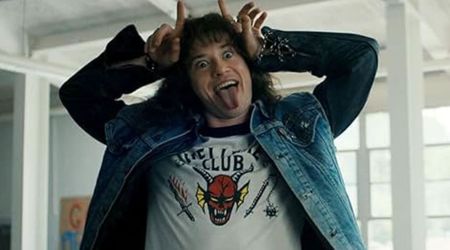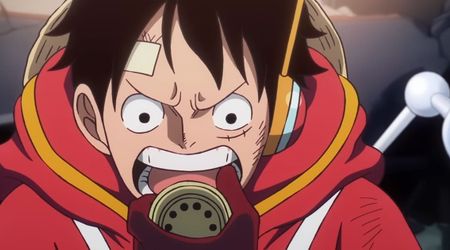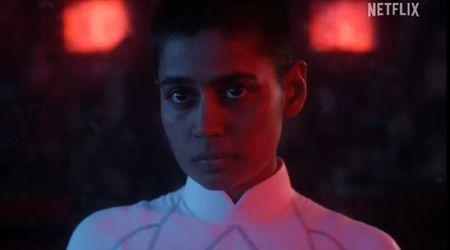'Watchmen': Five major links connecting Looking Glass and Rorshach

HBO’s ‘Watchmen’, while being rife with complex storytelling, isn’t subtle when it comes to its messages, metaphors and references. So when paranoid police officer Looking Glass (Tim Blake Nelson) sits alone at home, eating beans from a can, it was a signal to everyone that Looking Glass is the show’s Rorschach, a major character from the 1986 ‘Watchmen’ comic.
While the characters differ from each other in a number of ways, core themes remain similar, and a closer look at the parallels offers insight into Looking Glass’ role on the HBO series.
1. The Mask
Both characters have distinctive masks on top of relatively simple costumes. With just the mask removed, both characters can go about their day. However, Rorschach walks unrecognized in the pages of 'Watchmen' with no change made to his outfit but for his distinctive mask. Everything about their identity is tied to that mask. More interestingly, what's seen in both masks is subjective. Rorshach's mask is based on the psychological Rorschach Test, with random ink blobs shown to subjects, who each see different patterns emerging amongst the ink. Looking Glass' mask is a more accurate reflection of what's around him. However, Rorschach tests are based on personal interpretation.
So no matter what mask you look into, what you see looking back at you is yourself. And that's a terrible thing to be questioned by.
2. The Paranoia
It's not paranoia if they're really out to get you. Both Rorschach and Looking Glass dive deep into a conspiracy theories that they would love to be proved wrong about, but they know they aren't. Both characters are attracted to outlandish ideas, in the face of all rationality. Both are good enough detectives to be able to pick away at such theories, providing just enough merit to their respective beliefs to hold on to them. Then again, that's a trait characteristic of conspiracy theorists everywhere — some would argue that Rorschach and Looking Glass are intelligent enough to find, and twist, the facts that support their theories, but time and time again, their insights have proven to be less madness, and more intuitive leaps of genius. They are both people consumed by paranoia, but who could blame them?
3. Anti-social tendencies
Neither Looking Glass or Rorschach does especially well with people. They appear to mostly be at peace with this — they take other people's opinions of their character quirks in stride with a mixture of self-awareness and a lack of care. They know who they are, and won't change to make other people more comfortable. While they will work with other people they respect and admire, this leaves their personal life rather empty. Wade Tillman's paranoia has left him unable to maintain any kind of serious relationship for very long, whereas Rorschach abandoned his civilian identity years ago, seeing the Rorschach mask as his true face. It's a belief that Looking Glass has managed to avoid, but he already has shown signs of being more comfortable with his mask than without.
4. Christian absolutism
The characters approach moralism and faith from different angles, but Christian absolutism is a defining part of both of their lives. What's left of Rorschach's civilian life as Walter Kovacs is spending time traipsing about New York with a sign warning of the approaching apocalypse. He judges people with the same sense of black and white that makes up his mask, dividing people neatly into the good and the evil. Wade Tillman started out eschewing the same beliefs for Jehovah's Witness, also prophesying the nearing end of the world around the same time. Wade Tillman has grown more reflective if you will. He has appeared to have grown out of that kind of absolutism, though, accepting that while he works for a greater good, there's a lot of moral greys mixed into his job, and the world around him.
5. The arc
Rorschach and Looking Glass' character arcs play out in a similar framework. Inspired by a past trauma and strongly ingrained sense of right and wrong, both characters don masks and work within the prevailing masked community to bring criminals to justice. Their characters come across a case that leads to a much larger conspiracy, one that completely upends their lives. In Rorschach's case, it led him to Adiran Veidt, and the Dimensional Incursion Event that would destroy half of New York. In the 'Watchmen' comic, Rorschach's absolutism is ultimately what ended him — he would not let the conspiracy sit, no matter what the consequences, and was killed as a result. In the 'Watchmen' TV show, Looking Glass saves his own life — and possibly that of Angela's (Regina King) family by compromising his morals and bowing to blackmail.
Looking Glass' story arc diverges from Rorschach's when the former bows to the conspiracy that threatens his life. However, that very conspiracy may still spell out the end for him, as members of the Seventh Kavalry are seen breaking into his house, armed to the teeth and ready to kill, ironically all bearing Rorschach masks. Should they succeed in their mission, they will bring Looking Glass' story full circle - and everyone knows that circles in 'Watchmen' are everywhere.
The next episode of 'Watchmen' airs December 1 on HBO.










